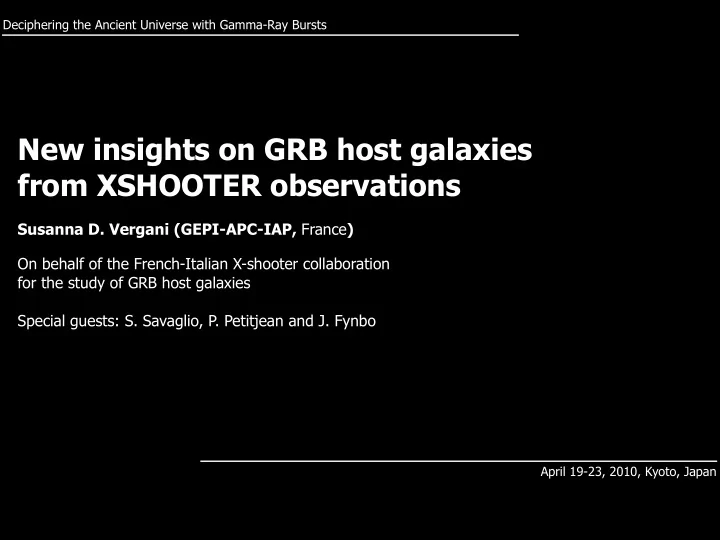

Deciphering the Ancient Universe with Gamma-Ray Bursts New insights on GRB host galaxies from XSHOOTER observations Susanna D. Vergani (GEPI-APC-IAP, France ) On behalf of the French-Italian X-shooter collaboration for the study of GRB host galaxies Special guests: S. Savaglio, P. Petitjean and J. Fynbo April 19-23, 2010, Kyoto, Japan
Deciphering the Ancient Universe with Gamma-Ray Bursts XSHOOTER: 2nd Generation instrument @ VLT 3 echelle spectrographs Full range 3000 – 24000 Å in a single shot Resolution 5000 – 10000 Slit length 11” Integral field unit 1.8" x 4” m(AB)~21 (1h, SNR=10; K(AB)~19) P.I. Board: Sandro D'Odorico (Chair), Francois Hammer, Lex Kaper, Per Kjaergaard Rasmussen, Sofia Randich Project Manager: Hans Dekker Instrument Scientists: Joël Venet (Garching), Elena Mason (Paranal) April 19-23, 2010, Kyoto, Japan
Deciphering the Ancient Universe with Gamma-Ray Bursts Open to the community from October 2009 Consortium GTO time : partly dedicated to GRB science French-Italian GTO to study GRB host galaxies : about 160 hours over 3 years PIs : Silvia Piranomonte (INAF-Rome) / Hector Flores (GEPI-Paris) Slit spectroscopy: z ≳ 1 host galaxies IFU observations: z<1 host galaxies Velocity field and a velocity dispersion map for each detected emission line. Electron density, metallicity, extinction and star formation measures. April 19-23, 2010, Kyoto, Japan
Deciphering the Ancient Universe with Gamma-Ray Bursts Open to the community from October 2009 Consortium GTO time : partly dedicated to GRB science French-Italian GTO to study GRB host galaxies : about 160 hours over 3 years PIs : Silvia Piranomonte (INAF-Rome) / Hector Flores (GEPI-Paris) Slit spectroscopy: z ≳ 1 host galaxies Extend emission lines spectroscopic host galaxy studies to high redshift : SFR, extinction, metallicity... (e.g. Savaglio et al. for z<1) Comparison with GRB-DLAs Comparison with surveys of galaxies April 19-23, 2010, Kyoto, Japan
Deciphering the Ancient Universe with Gamma-Ray Bursts New instrument : first selection based on galaxies with one or more emission lines already detected in the optical GRB 021004 z~2.3 } November 2009 GRB 000210 z~0.8 GRB 000911 z~1.1 GRB 990506 z~1.3 } March 2010 GRB 011211 z~2.1 GRB 000418 z~1.1 } GRB 060801 z~1.3 Now GRB 030328 z~1.5 GRB 080520 z~1.5 GRB 000210 : [OII], [OIII], H-gamma, H-beta, H-alpha Piranomonte et al. in preparation April 19-23, 2010, Kyoto, Japan
Deciphering the Ancient Universe with Gamma-Ray Bursts GRB 021004 One of the best studieded GRB Afterglow light curve sampled from X to radio VLT/UVES afterglow spectrum (and many other) Lyman-alpha emission in the afterglow spectrum HST host galaxy observations UVB to NIR (Fynbo et al. 2005) : m_r= 24.4 Blue starburst galaxy Tentative [OIII] and H-alpha VLT/ISAAC detections (Castro-Tirado et al. 2010) SCUBA observations (Tanvir et al. 2004) : no detection April 19-23, 2010, Kyoto, Japan
Deciphering the Ancient Universe with Gamma-Ray Bursts Absorbers at z=2.3289 Emission of Lyman-alpha z=2.33167 UVES afterglow spectrum ∆ v=250km/s Absorption up to 3000km/s: WR wind ? (Fiore et al. 2005;...) Close-by galaxy ? (Chen et al. 2007;....) April 19-23, 2010, Kyoto, Japan
Deciphering the Ancient Universe with Gamma-Ray Bursts 2 strong MgII intervening systems (Vergani et al. 2009;...) MgII doublet Wr = 1.6 Å Wr = 1.4 Å [OIII] emitter at 16'' ~100 kpc Vreeswijk et al. 2003 April 19-23, 2010, Kyoto, Japan
Deciphering the Ancient Universe with Gamma-Ray Bursts X-shooter observations (nodding) Slit position 1 Slit UVB 1.0'' R=5100 t_exp=4800 VIS 0.9'' R=8800 t_exp=4800 NIR 0.9'' R=5100 t_exp=5200 Slit position 2 Slit UVB 1.0'' R=5100 t_exp=3600 VIS 0.9'' R=8800 t_exp=3600 NIR 0.9'' R=5100 t_exp=5200 Slit position 3 Slit UVB 1.6'' R=3300 t_exp=4800 VIS 1.5'' R=5400 t_exp=4800 NIR 1.5'' R=3300 t_exp=5200 April 19-23, 2010, Kyoto, Japan
Deciphering the Ancient Universe with Gamma-Ray Bursts Preliminary results (Vergani et al. in preparation) detection of [OIII]5700 Å doublet, H-alpha, Ly-alpha H-beta on a sky line tentative NII Limit for [OII] ; [OIII]/[OII] > 4 Integrated continuum only detection 2D NIR spectrum (slit position 1) [OIII]; z = 2.33102 [OIII]5007 Å April 19-23, 2010, Kyoto, Japan
Deciphering the Ancient Universe with Gamma-Ray Bursts 2D UVB spectrum z = 2.33177 Spatially more extended than [OIII] Asymmetric profile typical of LAE [OIII] Shift of about 70 km/s Ly-alpha April 19-23, 2010, Kyoto, Japan
Deciphering the Ancient Universe with Gamma-Ray Bursts Lyman-alpha absorption difference of 1/10 only (a few 10^17 ergs/s/cm 2 ) XSHOOTER UVES UVES April 19-23, 2010, Kyoto, Japan
Deciphering the Ancient Universe with Gamma-Ray Bursts Verhamme et al. 2006 NHI, Vexp, b 1 Properties and distribution 2 of the neutral gas 3 April 19-23, 2010, Kyoto, Japan
Deciphering the Ancient Universe with Gamma-Ray Bursts Extended Lyman-alpha emission Jakobsson et al. 2005 1 2 about 1/7 of the total flux 3 April 19-23, 2010, Kyoto, Japan
Deciphering the Ancient Universe with Gamma-Ray Bursts galaxy ‘A’ [OIII] 5007 Å host Interactions between the host and ‘A’ ? High velocity absorbers: outflowing gas ? IFU observations No detections of intervening absorbers counterparts A April 19-23, 2010, Kyoto, Japan
Deciphering the Ancient Universe with Gamma-Ray Bursts LATEST NEWS FeII, FeII*, CrII, ZnII, MgII and MgI absorption lines z=0.6235 GCN 10620 April 19-23, 2010, Kyoto, Japan
Deciphering the Ancient Universe with Gamma-Ray Bursts [OIII]4959 [OIII]4959 [OIII]5007 H- γ [OII] H- β H- δ April 19-23, 2010, Kyoto, Japan
Deciphering the Ancient Universe with Gamma-Ray Bursts H- α April 19-23, 2010, Kyoto, Japan
Recommend
More recommend